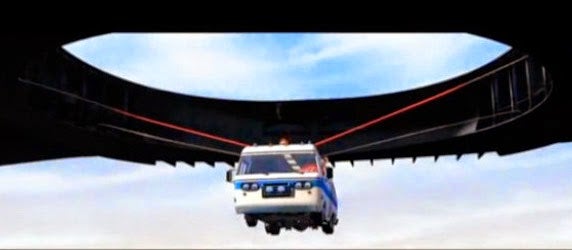 by "ttyymmnn" (ttyymmnn)
by "ttyymmnn" (ttyymmnn)
Published 11/28/2017 at 12:33
 by "ttyymmnn" (ttyymmnn)
by "ttyymmnn" (ttyymmnn)
Published 11/28/2017 at 12:33
Tags: planelopnik history
; planelopnik
STARS: 12
!!! UNKNOWN CONTENT TYPE !!!
Welcome to
This Date in Aviation History
, getting of you caught up on milestones, important historical events and people in aviation from November 25 through November 28.
!!! UNKNOWN CONTENT TYPE !!!
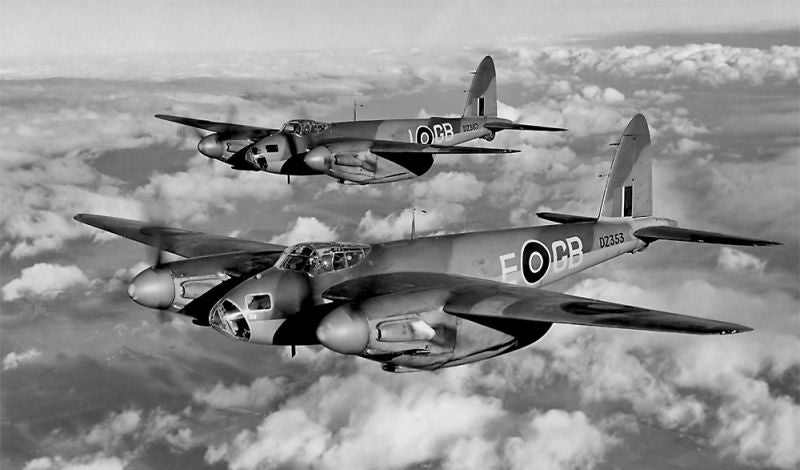
November 25, 1940 – The first flight of the de Havilland Mosquito. The de Havilland Aircraft Company was founded Geoffrey de Havilland in 1920, and quickly made a name for itself with the development of very fast airplanes, as well as their use of wood to make light yet strong airframes. The company garnered fame with their DH.88 , a twin-engine, wooden framed air racer that took top honors at the 1934 MacRobertson Air Race . The wooden skeleton of the DH.88 was covered with spruce plywood, and the twin engines produced an enormous amount of power for such a light, yet strong, airframe. De Havilland further refined their wood-working skills with the DH.91 Albatross , a four-engine passenger plane with skin made from a sandwich of two pieces of plywood encasing a layer of balsa wood, creating a very strong, yet very light, aircraft.
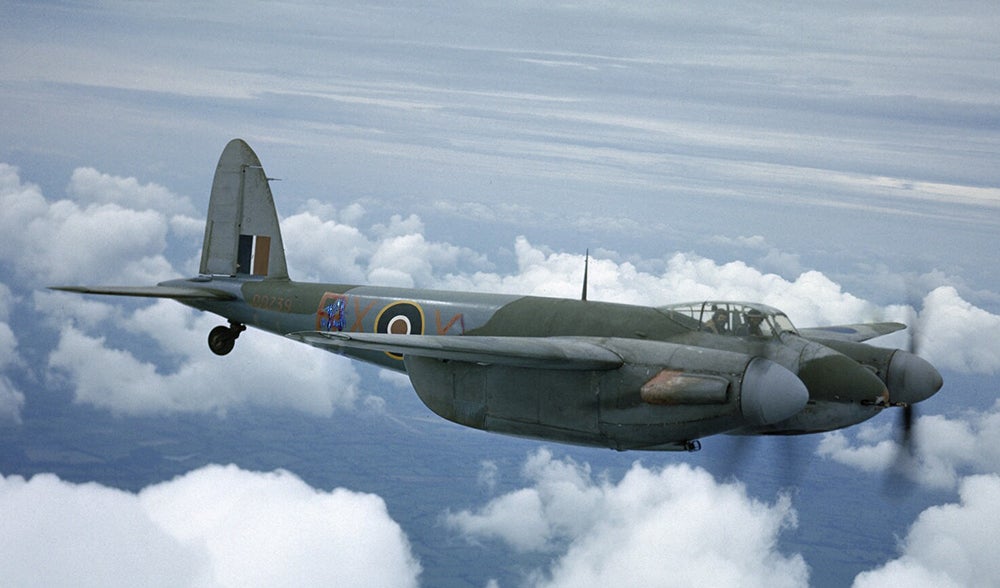
In 1936, the British Air Ministry issued Specification P.13/36 calling for a twin-engine medium bomber that could carry 3,000 pounds of bombs, and aircraft designers replied with traditional heavy bombers such as the
Avro Manchester
and
Handley Page Halifax
. But de Havilland believed that a lightweight, simple design could carry the same load at even higher speeds, perhaps even outpacing modern fighter planes. The idea was similar to the German
Schnellbomber
concept, which proposed that fast medium bombers could outrun enemy fighters and would not need defensive armament or extra crewmen. Following this idea, and drawing on its previous experience with wooden aircraft, de Havilland made their new bomber out of wood, which provided a strength to weight ratio that was as good as
Duralumin
or steel, and also preserved metals in a time of war. They also followed their earlier design ethos of putting the most powerful engine possible with the lightest airframe possible. Though the design showed promise, some in the RAF were hesitant to accept such a radical aircraft, so the Mosquito was initially adopted for reconnaissance missions to test its mettle, then developed into a high-speed fighter with the addition of forward armament.
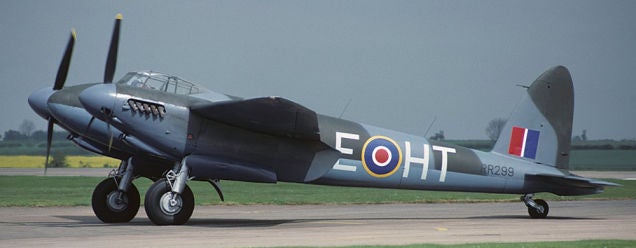
Powered by a pair of
Rolls-Royce Merlin
engines, the “Mossie” made its first flight just 11 months after detailed design work began, and further tests proved that the Mosquito was indeed as fast as promised. Its top speed of 392 mph outpaced the
Supermarine Spitfire Mk II
by 3o mph, though it was twice as heavy and twice as big. The Mosquito proved to be a jack of all trades for the RAF, fulfilling the roles of reconnaissance, bomber, fighter, night fighter, trainer, torpedo bomber and target tug. Produced until 1950, over 7,700 were built, including over 1,100 in Canada, and the Mosquito served the air forces of 21 countries. Despite the early reluctance over its adoption, the Mossie ended the war with the lowest loss rate of any aircraft in the RAF Bomber Command, and the Germans were so impressed with the British
Schnellbomber
that they named their own all-wood
Focke-Wulf Ta 154
, nicknamed the
Moskito
, perhaps in homage to the brilliant de Havilland design.
(Photo author unknown; RAF photo; Photo by Mike Freer via
Wikimedia Commons
)
!!! UNKNOWN CONTENT TYPE !!!
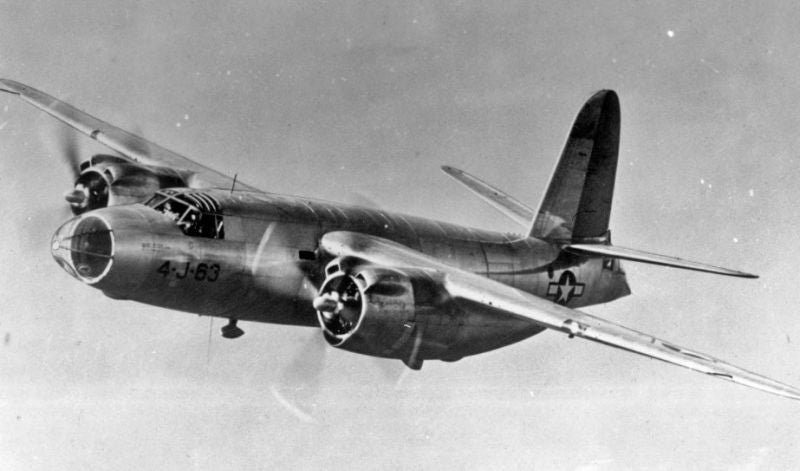
November 25, 1940 – The first flight of the Martin B-26 Marauder. World War II is often associated with the large strategic bomber, such as the Boeing B-17 Flying Fortress or the Boeing B-29 Superfortress . But even though those bombers could carry a large load, not all missions required the biggest bomb load possible, and there remained a need for a smaller, twin-engine bomber that could take on tactical targets at lower levels and with greater accuracy. For that mission, the US Army Air Forces had the Douglas A-20 Havoc and the North American B-25 Mitchell , but, in 1939, the USAAF issued Circular Proposal 39-640 that called for a new high-speed, twin-engine bomber with a top speed of 350 mph that could carry up to 2,000 pounds of bombs at a range of 3,000 miles. In July of that year, the Glen L. Martin Company proposed their Model 179 to fulfill that requirement, and, with all out war looming, the new bomber was accepted before any prototype flew, and the USAAF ordered 201 aircraft off the drawing board. In 1940, an additional 930 Marauders were ordered, still before the first aircraft ever left the ground.

Like the other medium bombers then in service, the B-26 featured a shoulder-mounted wing with two engines slung underneath. It was powered by a pair of
Pratt & Whitney R-2800 Double Wasp
18-cylinder radial engines and had a crew of seven: two pilots, bombardier, navigator, and three defensive gunners. The first production Marauder served as the flying prototype, and soon after it entered service it became clear that the emphasis on speed had an unfortunate side effect for the pilots. The relatively small wing, which was designed for high speed performance, also created particularly high
wing loading
, which resulted in higher landing speeds than many pilots had experienced in other aircraft. Inexperienced pilots, particularly trainees, discovered that if they dropped under 120-135 mph on landing, depending on the weight of the aircraft, the Marauder would stall and crash. The bomber gained the nickname “Widowmaker,” and pilots training in Florida began to chant, “One a day in Tampa Bay.” Other structural issues beset the early Marauders, and many pilots believed that the bomber could not be flown on one engine, until more experienced pilots, including
Jimmy Doolittle
, proved that it could be flown safely.

Even when these difficulties were solved, including a redesign of the wing, the B-26 remained a demanding aircraft to fly, but it ended the war with the lowest combat loss rate of any US aircraft. The Marauder first saw action in the Pacific Theater in 1941, and eventually served with distinction in every theater of the war. By the close of WWII, Marauders had flown more than 110,000 sorties and accounted for more than 150,000 tons of bombs dropped while serving with the US, Britain, Free France and South Africa. Production ended in 1945 after more than 5,200 Marauders had been built, and the type was retired by 1947.
(US Air Force photo; Photo author unknown; US Air Force photo)
!!! UNKNOWN CONTENT TYPE !!!
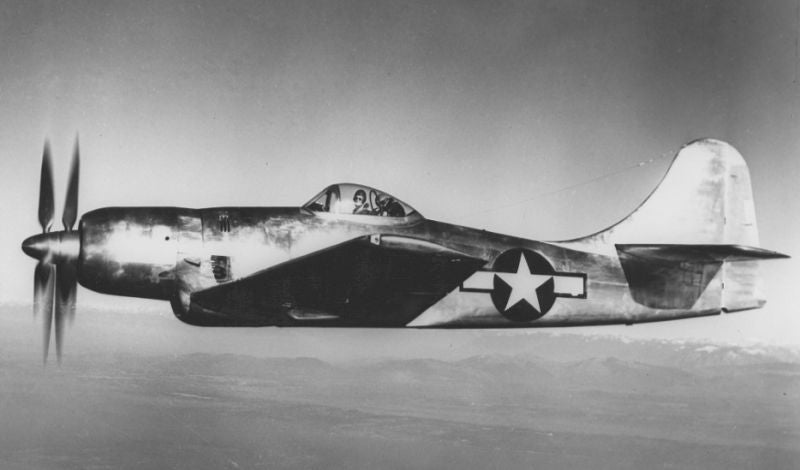
November 27, 1944 – The first flight of the Boeing XF8B. In the Pacific theater of WWII, the US Navy was faced not only with conquering the Japanese, but also conquering the ocean’s vast distances. Carrier aircraft, small by necessity, had relatively short range, and that limited the extent to which they could reach out and attack land targets or Japanese ships. But the Navy knew that the closer they got to the Japanese homeland, the closer the fleet, with its vulnerable carriers, would be to land-based bombers. What the Navy wanted was an aircraft that would have enough range to reach Japan while leaving the carriers farther away in relative safety.
Once over the target, the aircraft had to be capable of many different missions. So the Navy told Boeing that it wanted a five-in-one solution: a fighter/dive bomber/interceptor/level bomber/torpedo bomber all in one package. Though Boeing’s area of expertise was in large warplanes like the
B-17 Flying Fortress
and
B-29 Stratofortress
, they set to work on what they designated the Model 400. The massive fighter, indeed the largest piston-powered, single-seat US fighter developed during WWII, was be powered by an equally massive
Pratt & Whitney R-4360 Wasp Major
supercharged 28-cylinder four-row radial engine, the largest-displacement piston aircraft engine to be developed during the war and the same engine that powered the postwar
B-50 Superfortress
. The Wasp Major turned a huge,
contra-rotating
, six-bladed propeller that pulled the XF8B through the air at a top speed of 432 mph.

The XF8B packed a heavy punch, with either six .50 caliber machine guns or six 20mm cannons in the wings. Utilizing underwing hard points and an internal bomb bay, it could carry 6,400 pounds of bombs or two 2,000 pound torpedoes. To put that into some perspective, the four-engine B-17 carried 8,000 pounds of bombs on a short-range mission, and 4,500 pounds of bombs on a long-range mission, and the XF8B’s range was 2,800 miles, almost than twice that of the Vought F4U Corsair . Its wingspan was also greater than the Corsair’s by 13 feet.
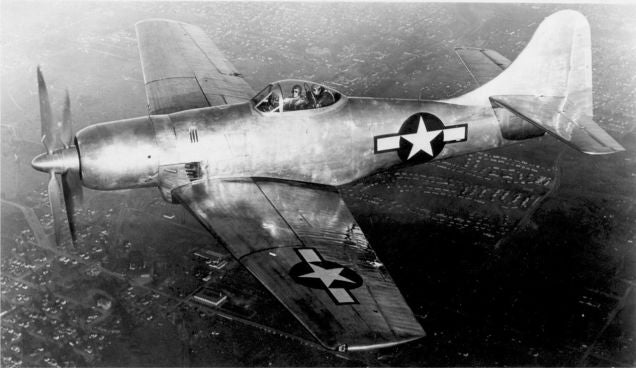
Boeing received an order for three prototypes in May of 1943, and, since the Navy perceived an urgent need for the XF8B, the testing and evaluation process was expedited by the addition of a second cockpit to the first two prototypes to allow a flight engineer to accompany the pilot and collect data. There was no shortage of space for a second seat. Despite the urgency, the war ended before the second and third prototypes could be completed. With the advent of the jet fighter following the war, and Boeing’s continued emphasis on building large bombers and transports for the looming Cold War, the XF8B was canceled when the Navy wanted to buy a only handful of them and the Air Force simply wasn’t interested in a piston-powered fighter. The three XF8B prototypes were consigned to the scrapyard. (US Air Force photos)
!!! UNKNOWN CONTENT TYPE !!!
!!! UNKNOWN CONTENT TYPE !!!
!!! UNKNOWN CONTENT TYPE !!!
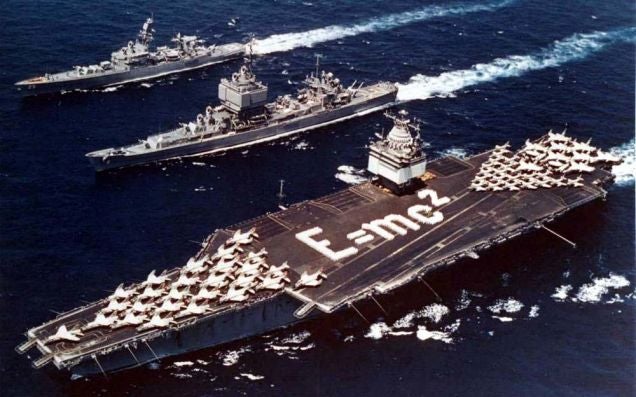
November 25, 1961 – The USS Enterprise is commissioned. The USS Enterprise (CVN-65) was the eighth US Naval vessel to bear the name and the world’s first nuclear-powered aircraft carrier. Ordered on November 15, 1957, Enterprise was built at Newport News Shipbuilding in Virginia and still holes the record for the longest naval vessel in the world. After her maiden voyage in 1960, Enterprise saw action during the Cuban Missile Crisis and the Vietnam War , as well as the Iraq War . After more than 50 years of service, Enterprise was deactivated on December 1, 2012 and struck from the Naval Vessel Register on February 3, 2017. It now awaits scrapping and recycling. The next Gerald R. Ford-class carrier , CVN-80, will be named Enterprise . (US Navy photo)
!!! UNKNOWN CONTENT TYPE !!!

November 26, 1985 – The launch of Space Shuttle Atlantis , carrying Rodolfo Neri Vela, the first astronaut from Mexico. Vela, a professor in the Telecommunications Department in the Electrical Engineering Division at the National Autonomous University of Mexico , flew on board Atlantis as a Payload Specialist , helping to launch three communications satellites and carrying out various scientific experiments, including special experiments for the Mexican government. Vela, the second Latin-American astronaut (after Cuban Arnaldo Tamayo Méndez ), logged over 165 hours and in space and completed 108 orbits of the Earth. (NASA photo)
!!! UNKNOWN CONTENT TYPE !!!
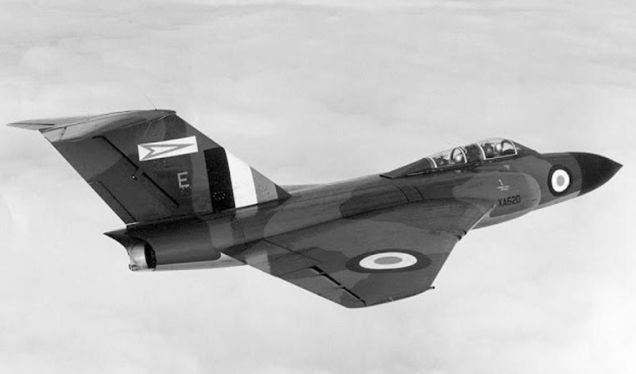
November 26, 1951 – The first flight of the Gloster Javelin, a twin-engine, delta-wing interceptor and night fighter. It was also the first purpose-built, all-weather interceptor developed for the RAF, and the last in the Gloster Aircraft Company line of jets that began with the Meteor , Britain’s first jet fighter. The subsonic Javelin served the Royal Air Force from the mid-1950s through the 1960s, and was eventually replaced by the supersonic English Electric Lightning , though the two served together for much of the Javelin’s operational career. While the Javelin never saw any actual combat, it did serve in a number of global hot spots during its career, and was retired in 1968 after the construction of 436 aircraft. (UK government photo)
!!! UNKNOWN CONTENT TYPE !!!
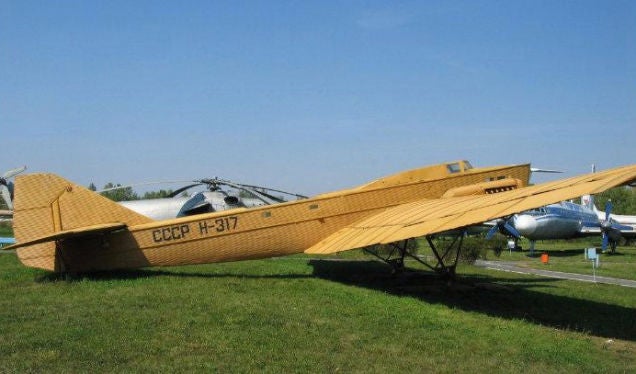
November 26, 1925 – The first flight of the Tupolev TB-1, a large, twin-engine bomber developed by Andrei Tupolev for the Soviet Air Force. The Soviet Union’s first large, all-metal aircraft, the TB-1 employed a corrugated Duralumin skin originally pioneered by Hugo Junkers , and was so large that a wall of the factory had to be knocked down to get it out. Powered by a pair of Mikulin M-17 liquid-cooled V-12 engines (license-built BMW VI ), the TB-1 had a top speed of 111 mph and could carry 2,205 pounds of bombs. Following a 13,194 mile promotional flight from Moscow to New York, the TB-1 entered service as the Soviet Union’s standard heavy bomber, and was fitted with either traditional landing gear or floats. A total of 218 were built, and the TB-1 was eventually replaced by the much larger Tupolev TB-3 . (Photo by Timofey210696 via Wikimapia )
!!! UNKNOWN CONTENT TYPE !!!
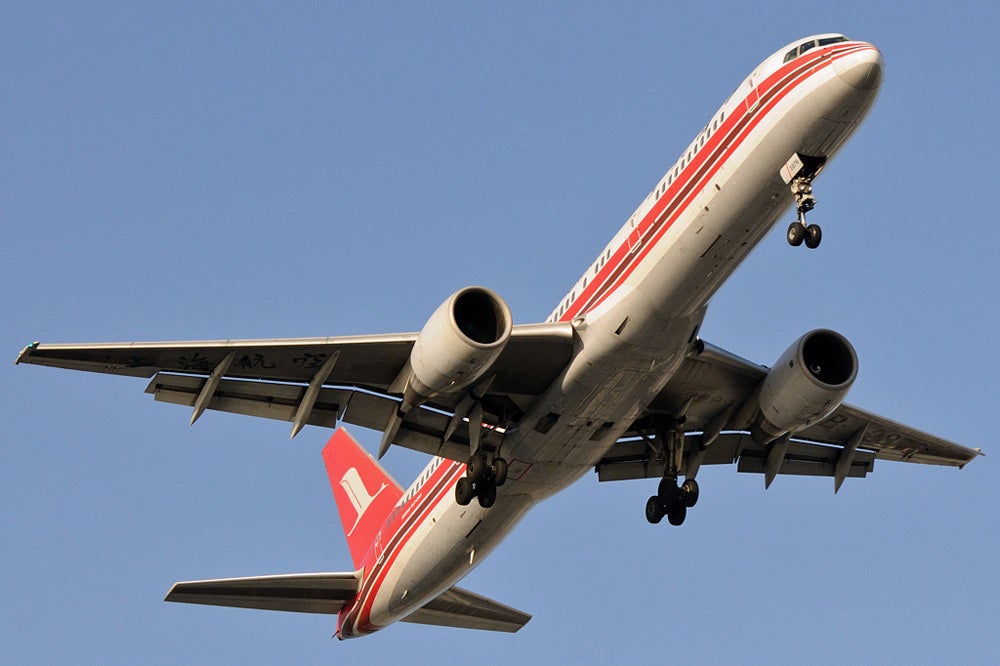
November 27, 2005 – Boeing delivers the 1,050th and final 757.
Designed as a larger replacement for the three-engined
Boeing 727
while retaining the 727's short field capabilities, the 757 took its maiden flight on February 19, 1982 and entered service with
Eastern Air Lines
on January 1, 1983. The 757 was developed concurrently with the wide-body
Boeing 767
, and shares the essentially the same cockpit, allowing crews to easily transition between the two types. Of the 1,050 produced, 913 were built as the 757-200 which seats up to 239 passengers. Production of the 757 ended in October 2004 as Boeing shifted emphasis to further development of the
Boeing 737
, and 688 757s remained in service as of July 2016.
(Photo by Shimin Gu via
Wikimedia Commons
)
!!! UNKNOWN CONTENT TYPE !!!

November 27, 1949 – The first flight of the Douglas C-124 Globemaster II. The C-124 was developed from the smaller C-74 Globemaster , and served the Military Air Transport Service (MATS) as the primary heavy lift cargo and passenger carrier throughout the 1950s and into the 1960s before it was replaced by the jet-powered Lockheed C-141 Starlifter . The C-124 could carry 68,500 poulds of cargo, including tanks, bulldozers and other heavy equipment without needing to disassemble them prior to loading. It could also carry 200 fully equipped troops on its two passenger decks. The Globemaster II served in the Korean and Vietnam Wars, and ended its career with the Air National Guard and Air Force Reserve. A total of 448 were produced, and 9 still survive as museum pieces. (US Air Force photo)
!!! UNKNOWN CONTENT TYPE !!!

November 27, 1969 – The first flight of the IAI Arava, a light short takeoff and landing (STOL) utility aircraft and the first major design by Israeli Aircraft Industries to enter production. In order to achieve IAI’s design goals of carrying up to 20 passengers while maintaining STOL and unprepared runway capability, the Arava has a large central fuselage placed between a twin-boom tail and high wing, and the rear of the fuselage can be opened for cargo loading. The Arava is powered by two Pratt & Whitney Canada PT6 turboprop engines, and first saw service in the Yom Kippur War of 1973, though the Israeli Air Force did not buy them in any numbers until 1988. The majority serve primarily in third world countries. (Photo by Oscar Vasquez via Wikiwand )
!!! UNKNOWN CONTENT TYPE !!!
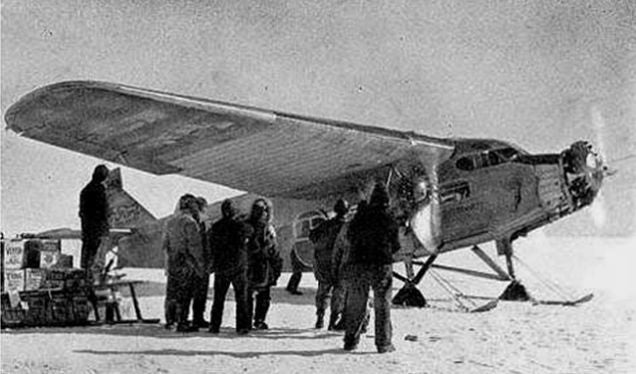
November 27-28, 1929 – Richard Byrd and his crew make the first flight over the South Pole. Explorer Richard Byrd began his first expedition to the South Pole in 1928, taking two ships and three airplanes for use in exploration. After establishing a base camp on the Ross Ice Shelf , Byrd and his crew took off in a Ford Trimotor named Floyd Bennett in honor of the recently deceased pilot from Byrd’s previous expeditions. During a round trip flight of 18 hours, in which they jettisoned much of their equipment to maintain altitude, the team crossed the South Pole and returned to base. For his exploits, Byrd was promoted to the rank of rear admiral at the age of 41, becoming the youngest admiral in the history of the US Navy. (Photo author unknown)
!!! UNKNOWN CONTENT TYPE !!!
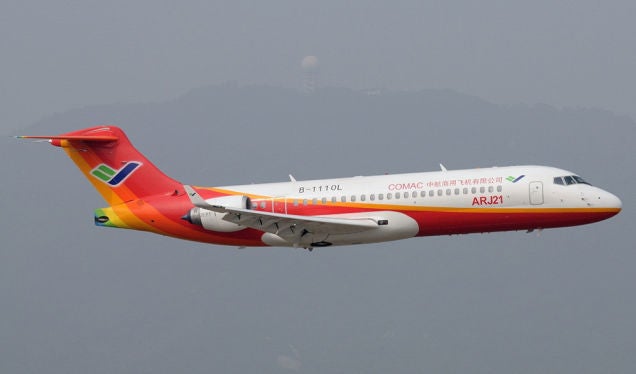
November 28, 2008 – The first flight of the Comac ARJ21, a narrow-body, twin-engine regional airliner built by Commercial Aircraft Corporation of China (Comac) as part of an effort to reduce reliance on foreign aircraft manufacturers. The ARJ21 bears a significant resemblance to the McDonnell Douglas MD-80 , but Comac says that they did not copy the American airliner, though they did reuse tooling provided by McDonnell Douglas for the construction of license-built MD-80s in China. The ARJ21 also features a new supercritical wing that was designed with the help of Russian engineers. The ARJ21 entered service in June 2016, and Comac currently has over 300 orders for the regional jet, mostly with Chinese carriers. (Photo by Shimin Gu via Wikimedia Commons )
!!! UNKNOWN CONTENT TYPE !!!

November 28, 1979 – The crash of Air New Zealand Flight 901, a sightseeing flight that operated regularly from Auckland, New Zealand and flew over Antarctica. On the 14th flight on the route, the McDonnell Douglas DC-10-30 (ZK-NZP) crashed into Mt. Erebus , the second highest volcano in Antarctica, killing all 257 passengers and crew. Initially, Air New Zealand blamed the crash on pilot error, but a Royal Commission of Inquiry found that the course the pilots usually flew on the return leg had been altered in the flight computer before the plane took off, and the pilots hadn’t been informed. Instead of flying over McMurdo Sound as planned, the plane flew into the volcano. The crash remains New Zealand’s deadliest peacetime disaster. (DC-10 photo by Eduard Marmet via Wikimedia Commons ; Mt. Erebus photo by Hannes Grobe via Wikimedia Commons )
!!! UNKNOWN CONTENT TYPE !!!
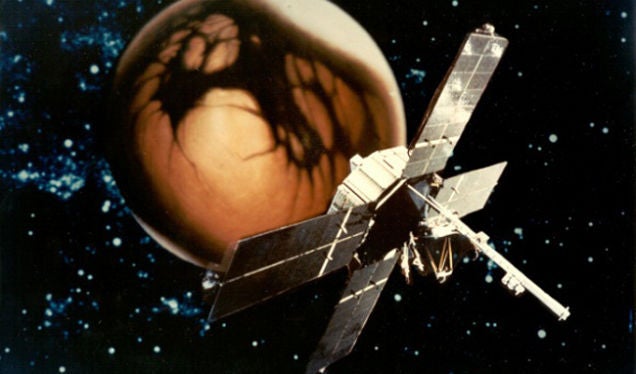
November 28, 1964 – The launch of Mariner 4, the fourth in a series of spacecraft designed for fly-by planetary exploration. On July 14-15, 1965, Mariner 4 became the first spacecraft to perform a fly-by of Mars and sent the first pictures of the planet’s surface back to Earth. With nothing visible but rocks and craters, the photographs changed many scientific opinions on the possibility of life on Mars. After two years without contact from the probe, NASA re-established communications in 1967, and recorded numerous micrometeoroid strikes on the spacecraft, leading NASA to suspect that Mariner 4 had flown through the remnants of a destroyed comet. In December 1967, NASA terminated communications with Mariner 4, and the derelict probe remains in a heliocentric orbit. (Illustration via NASA)
!!! UNKNOWN CONTENT TYPE !!!
!!! UNKNOWN CONTENT TYPE !!!
!!! UNKNOWN CONTENT TYPE !!!
!!! UNKNOWN CONTENT TYPE !!!
!!! UNKNOWN CONTENT TYPE !!!
!!! UNKNOWN CONTENT TYPE !!!
!!! UNKNOWN CONTENT TYPE !!!
If you enjoy these Aviation History posts, please let me know in the comments. And if you missed any of the past articles, you can find them all at
Planelopnik History
. You can also find more stories about aviation, aviators and airplane oddities at
Wingspan
.
!!! UNKNOWN CONTENT TYPE !!!
 "RamblinRover Luxury-Yacht" (ramblininexile)
"RamblinRover Luxury-Yacht" (ramblininexile)
11/28/2017 at 12:36, STARS: 2
As an interesting note to how the sides of the Mossie’s fuselage were built, and how the wings were constructed, it would not take anything but a large workshop space to build a fully accurate 66% replica. Not that I’ve thought about doing that or anything... okay I have.
 "For Sweden" (rallybeetle)
"For Sweden" (rallybeetle)
11/28/2017 at 12:38, STARS: 1
I’ve never seen a civilian B-26 and now I need one
 "ttyymmnn" (ttyymmnn)
"ttyymmnn" (ttyymmnn)
11/28/2017 at 12:41, STARS: 1
That would be awesome. In case it becomes more than just a passing thought, a trove of technical drawings for the Mossie were discovered back in August.
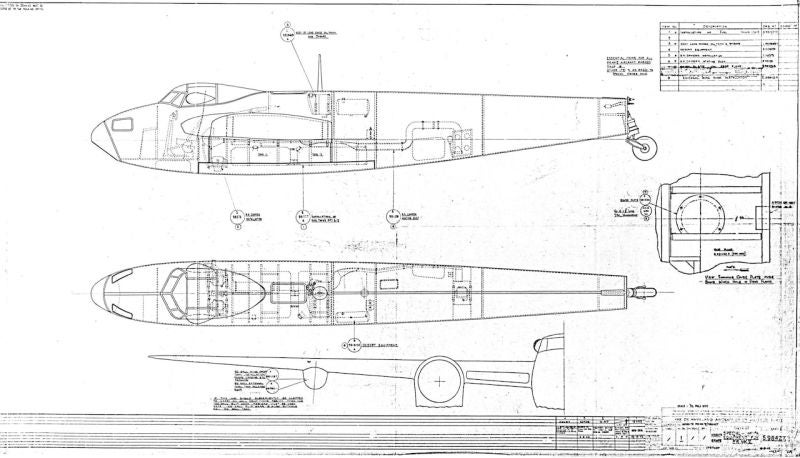
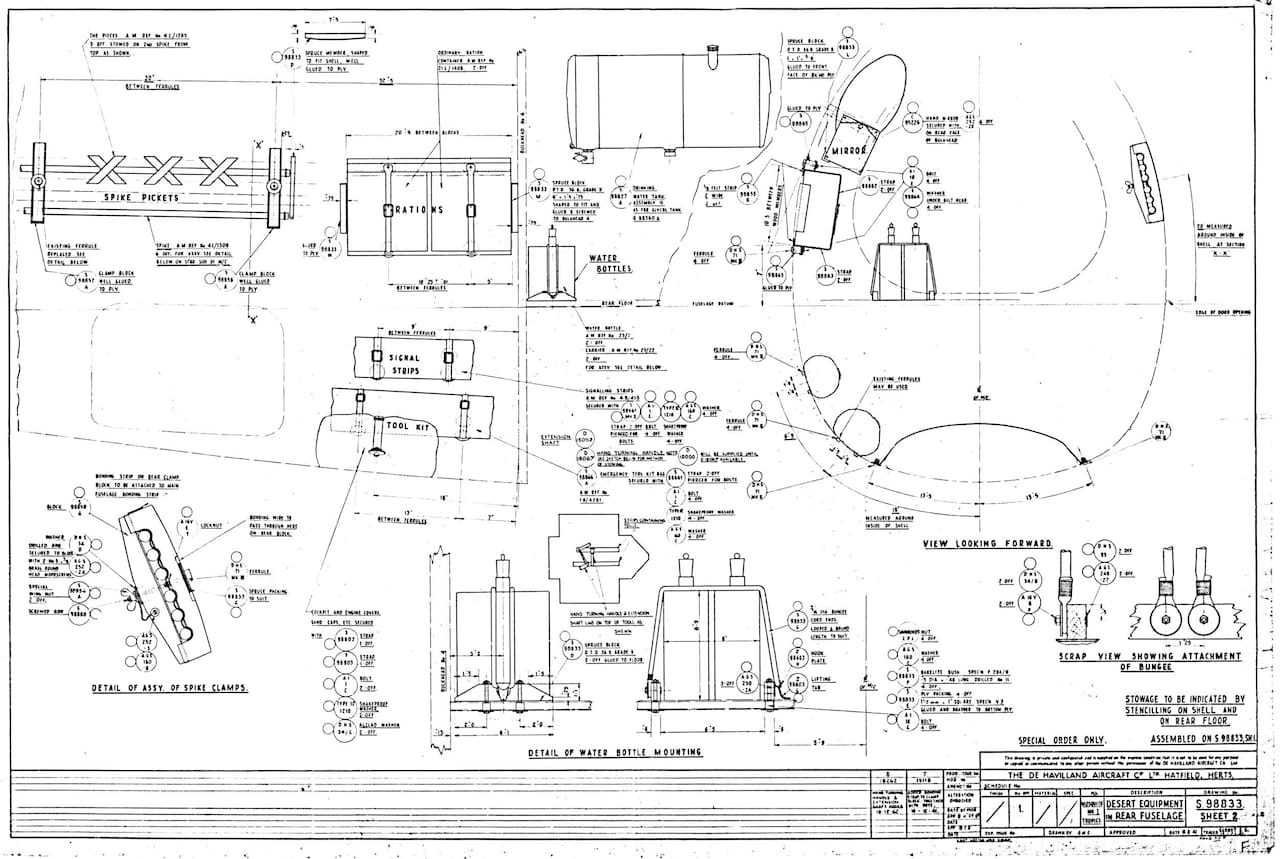
http://www.bbc.com/news/uk-wales-north-east-wales-40873628
 "RamblinRover Luxury-Yacht" (ramblininexile)
"RamblinRover Luxury-Yacht" (ramblininexile)
11/28/2017 at 12:43, STARS: 1
I had heard about this. It encouraged me more, though I’d already had the idea.
 "ttyymmnn" (ttyymmnn)
"ttyymmnn" (ttyymmnn)
11/28/2017 at 12:43, STARS: 1
I made a one-off post about that photo when I came across it last year. It’s gorgeous.
 "ttyymmnn" (ttyymmnn)
"ttyymmnn" (ttyymmnn)
11/28/2017 at 12:45, STARS: 0
I think the plans will be put on microfiche (if that’s even still a thing) and be made available to the public.
 "RamblinRover Luxury-Yacht" (ramblininexile)
"RamblinRover Luxury-Yacht" (ramblininexile)
11/28/2017 at 12:48, STARS: 1
The smart thing to do, obviously, would be to scale everything exactly just-so, and then put a simplified version of the result in CATIA or similar software to make sure there would be no surprises. Since some effects don’t stay consistent.
 "Demon-Xanth knows how to operate a street." (demon-xanth)
"Demon-Xanth knows how to operate a street." (demon-xanth)
11/28/2017 at 12:52, STARS: 1
I now want an Arava.
 "ttyymmnn" (ttyymmnn)
"ttyymmnn" (ttyymmnn)
11/28/2017 at 12:53, STARS: 1
That would probably make an awesome bush plane or flying camper.
 "Demon-Xanth knows how to operate a street." (demon-xanth)
"Demon-Xanth knows how to operate a street." (demon-xanth)
11/28/2017 at 13:24, STARS: 1
I’m thinking aircraft Ultravan.
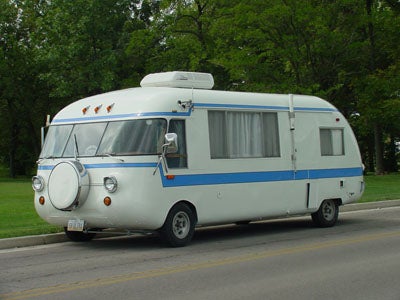

11/28/2017 at 14:55, STARS: 1
I haven’t found much, but that seems to be N171e, which was registered to Tenneco at the time. Here’s their F27 in 1979:
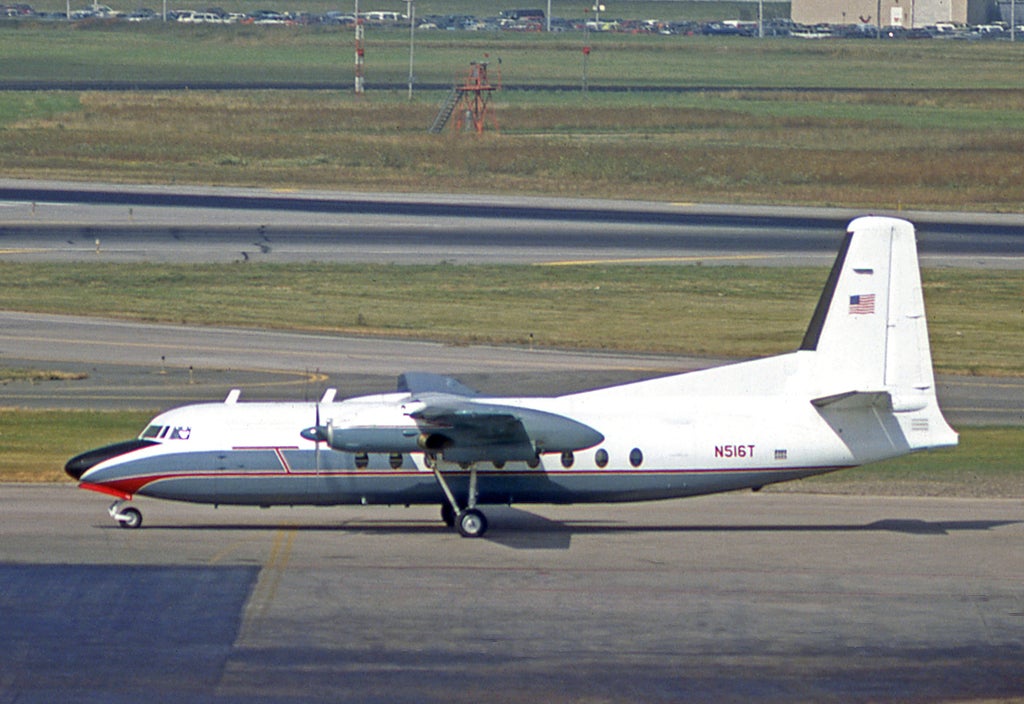
 "ttyymmnn" (ttyymmnn)
"ttyymmnn" (ttyymmnn)
11/28/2017 at 17:04, STARS: 0
